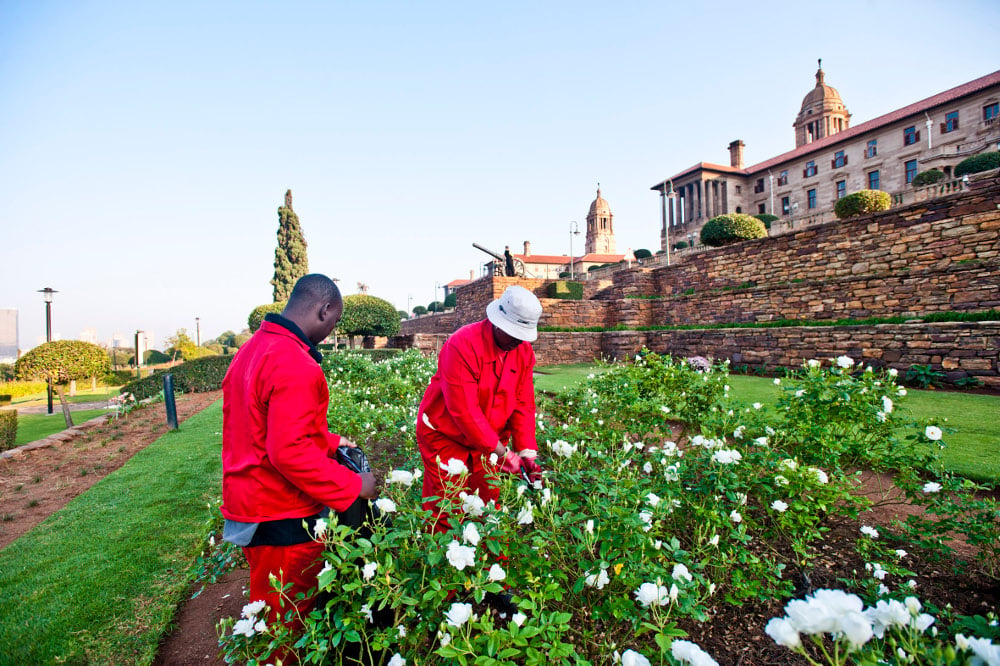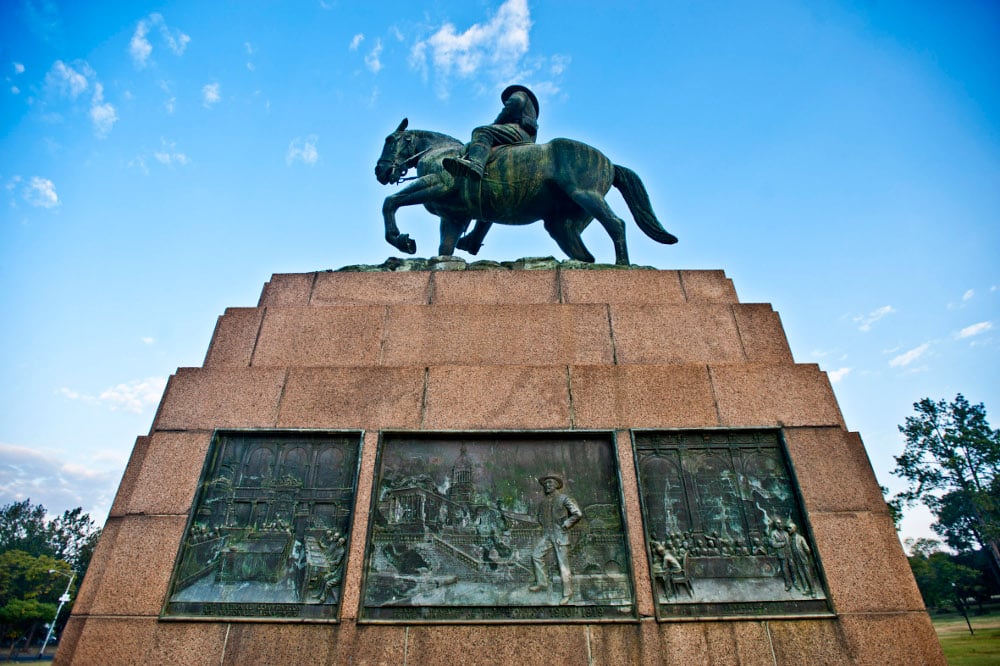The 11m-high Nelson Mandela sculpture embraces the layout of the Union Buildings.
According to the Heritage Portal, an invaluable online resource for those in either the heritage industry or who are concerned about the preservation of heritage, 14 statues countrywide have been vandalised in the past seven weeks.
Some examples, such as the statues of Paul Kruger and JG Strijdom in Krugersdorp, which were both painted red, would appear to be straightforward acts of political opposition or vandalism – depending on your view. Other acts, though, are more compellingly weird, expressive, perhaps, of a more generalised political and social dissatisfaction.
Take, for instance, the plaque commemorating Sara Baartman, in Hankey in the Eastern Cape. On the last weekend in April the plaque, which is near Baartman’s fenced-off grave, was splashed with white paint.
Baartman here is being commemorated for her largely unwitting role in lurid Western fantasies about her as the Kim Kardashian of her age. On the face of it at least, paint-splattering makes no sense.
She was, lest we forget, taken to Europe by a Scottish entrepreneur in about 1805, and paraded as a freak for her large buttocks and unusual genitalia. Such was then-contemporary lust masquerading as science that the eminent French naturalist, Georges Cuvier, examined her dismembered body after her death and for years parts of her skeleton, brains and anatomy were on display in Musée de l’Homme in Paris until they were removed from view in 1974.
Remains repatriated
Shortly after his inauguration, President Nelson Mandela campaigned for Baartman’s remains to be repatriated to South Africa and returned to her place of birth above the Gamtoos River valley in the Eastern Cape.
Among other things, the plaque is expressive of homecoming, return and closure. There is no obvious political explanation for this vandalism, other than as an expression of anxious masculinity.
Reports seem to contradict this, suggesting we’re dealing with a version of the “broken glass” syndrome, where anything official or commemorative becomes a magnet for the disaffected’s dissatisfaction.
The 14 listed acts of opposition, contempt or ignorance (take your pick) led the portal to gingerly suggest that perhaps we are in the midst of a “revolution”, although the situation is more complicated than the media-driven frenzy tends to depict.
James Ball, the unflagging mastermind behind the Heritage Portal, puts it as follows: “Although the tempo and ferocity of attacks increased dramatically in recent months, the neglect and vandalism of plaques, statues, monuments and other heritage resources is an ongoing problem. This is the real epidemic in my view.”
Better position than most
As someone who painstakingly itemises all instances of vandalism, all the debates in the heritage industry as well as more mundane queries about the value of their Oregon pine floorboards from the likes of “Perplexed of Buccleuch”, Hall is in a better position than most to give a reading from ground zero.
At the same time, the media has clearly fanned the flames of the statue debate, quickly turning some extremely obscure or minor examples of desecration into a general trend – a service delivery protest at one remove.

The grounds of the Union Buildings contain more than 1 000 rose bushes. (Photos: Delwyn Verasamy, M&G)
It is a trend that appears to have slowed, with the last example of vandalism taking place at the end of April and few being reported since, although perhaps the story’s life cycle has simply come to a natural end and vandalism continues but now goes largely unreported.
One symbolically significant site for all South Africans that doesn’t appear to have been affected by the anger towards “colonial monuments” is the Union Buildings and its terraced grounds.
Pride of place in the grounds at the base of the buildings is an 11m- tall statue of Mandela, but we are clearly dealing with a broad church. At Mandela’s feet, in the direction of Stanza Bopape Street, first prime minister of the union Louis Botha and his horse are caught in frozen gallop; scattered elsewhere are statues of later premier JBM Hertzog as well as rolls of honour to the dead of both World Wars.
Scrap-metal plunder
The rolls have suffered from scrap-metal plunder and although the Botha statue needs some tender loving care, it doesn’t appear to have attracted the anger Transvaal president Paul Kruger’s statue has, in Tshwane’s Church Square.
The reason might be practical: the statue is on a plinth, high off the ground, and to drape a noose over Botha’s neck, as has been done with a Queen Victoria statue in Port Elizabeth, would take a certain foolhardy ingenuity. Best perhaps that Botha be left as is: to pound into the political sunset, silent, heroic and largely invisible.
With so many politically incompatible figures rubbing shoulders in secret harmony, the grounds at the Union Buildings have an inclusive – even playful – feel.

A statue of Boer general Louis Botha on his steed in the grounds of the Union Buildings.
There is ample opportunity on the lawns and swept pathways for reverie and the panorama to the south – to the Tshwane city centre, Freedom Park further afield, and even a slice of the Voortrekker Monument – is magnificent, underlining the fact that the Union Buildings’ original site (which used to be a quarry) was carefully chosen by Botha, his successor Jan Smuts and Sir Herbert Baker, the architect.
There are other ways to make sense of the experience. I was touched by a scribbled inscription in black khoki at the top of one of the panels commemorating policemen who had lost their lives in the line of duty, both pre- and post-democracy.
The words read: “Constable M.T. Mollo – 12-03-2014”, a name forgotten by the indifference of officialdom but not, presumably, by Mollo’s relatives or loved ones. They made the pilgrimage to the Union Buildings to pay their respects and to see to it that others know he died protecting them. A small act of sedition in an otherwise vast, well-tended space.
Calming effect
The calming effect of the gardens is largely the work of one man, the chief horticulturalist, and his staff of 66 contracted workers. He was reluctant to give me his name or to be quoted for fear of getting into trouble, but was prepared to walk me through terrace after terrace of his expertly shaped garden.
It is a garden, he told me, that has more than 1 000 rose bushes in a variety of colours, ranging from deep blood red to tunic red, white and pink. His favourite rose is the Satchmo.
Named after jazz genius Louis Armstrong, it is not particularly fragrant, he said, but loud with What a Wonderful World connotations. He will be planting winter flowers soon, he added, May and June being the time of the petunia and the pansy.
Up above him, the Union Buildings open out like a wide, impressive fan. Baker, the architect, was a worldly man, so there are references within them ranging from Athens’s Acropolis to Big Ben. Built with convict labour and massaged into existence not only by Baker’s intellectual patrons such as Alfred Lord Milner and his famed “Kindergarten”, but also by Smuts and Botha themselves, both of whom were keen to have the seat of union power in the Transvaal rather than in the Cape.
Less known is the fact that the buildings’ two wings – joined by an amphitheatre – were built by Mattheus Meischke, a builder originally from the Netherlands. He was well regarded, although he wasn’t above a little corner-cutting.
The story is told, for example, that he built the Meischke building, on the corner of Harrison and Market streets in Johannesburg, with bricks he didn’t pay for. They were meant for the City Hall, another edifice he had the building contract for, but miraculously found their way elsewhere – because Meischke owned the wagons that transported them.